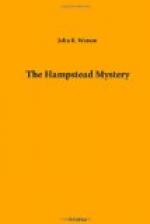“That’s a sound maxim for us all,” said Crewe. “However, let’s get to business. I rang up the Yard this morning and they told me you were in charge of the case and that I’d probably find you here. Can you let me have a look at the original of that letter which was sent to Scotland Yard informing you of the murder? There is a facsimile of it in the Daily Recorder this morning, and from all appearances there are some interesting conclusions to be drawn from it. But the original is the thing.”
“Here you are,” said the inspector, producing his pocket-book, taking out the paper, and handing it to Crewe. “What do you make of it?”
Crewe sat down, and placing the paper before him took a magnifying glass from his pocket. As he sat there, in his grey tweed suit, his hat pushed carelessly back from his forehead, he might have been mistaken for a young man of wealth with no serious business in life, for his clothes were of fashionable cut, and he wore them with an air of distinction. But a glance at his face would have dispelled the impression. The clear-cut, clean-shaven features riveted attention by reason of their strength and intelligence, and though the dark eyes were rather too dreamy for the face, the heavy lines of the lower jaw indicated the man of action and force of character. The thick neck and heavily-lipped firm mouth suggested tireless energy and abounding vitality.
“At least two people have had a hand in it,” he said, after studying the paper for a few minutes.
“In the murder?” asked the inspector, who was astonished at a deduction which harmonised with a theory which had begun to take shape in his mind.
“In writing this,” said Crewe, with his attention still fixed on the paper. “But of course you know that yourself.”
“Of course,” assented the inspector, who was surprised at the information, but was too experienced an official to show his feelings. “And both hands disguised.”
“Disguised to the extent of being printed in written characters,” continued Crewe. “It is so seldom that a person writes printed characters that any method in which they are written suggests disguise. The original intention of the two persona who wrote this extraordinary note was for each to write a single letter in turn. That system was carried as far as ‘Sir Horace’ or, perhaps, up to the ‘B’ in ‘Fewbanks.’ After that they became weary of changing places and one of them wrote alternate letters to the end, leaving blanks for the other to fill in. That much is to be gathered from the variations in the spaces between the letters—sometimes there was too much room for an intermediate letter, sometimes too little, so the letter had to be cramped. Here and there are dots made with the pen as the first of the two spelled out the words so as to know what letters to write and what to leave blank. Look at the differences in the letter ‘U.’ One of the writers makes it a firm downward and upward stroke; the other makes the letter fainter and adds another downward stroke, the letter being more like a small ‘u’ written larger than a capital letter. The differences in the two hands are so pronounced throughout the note that I am inclined to think that one of the writers was a woman.”




